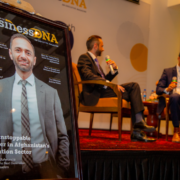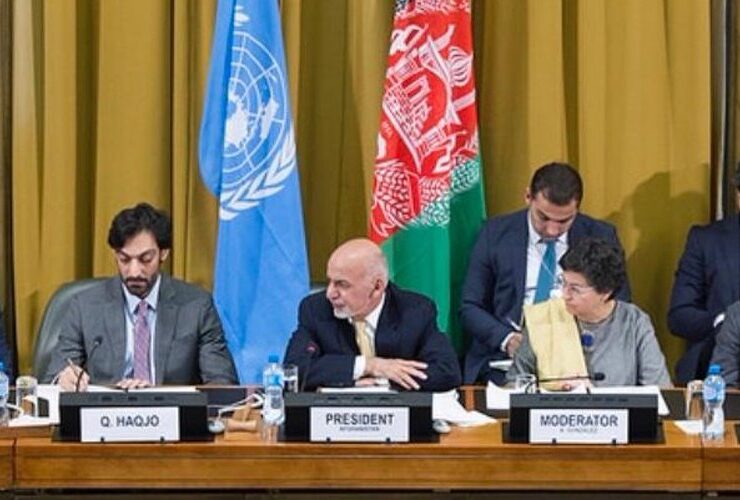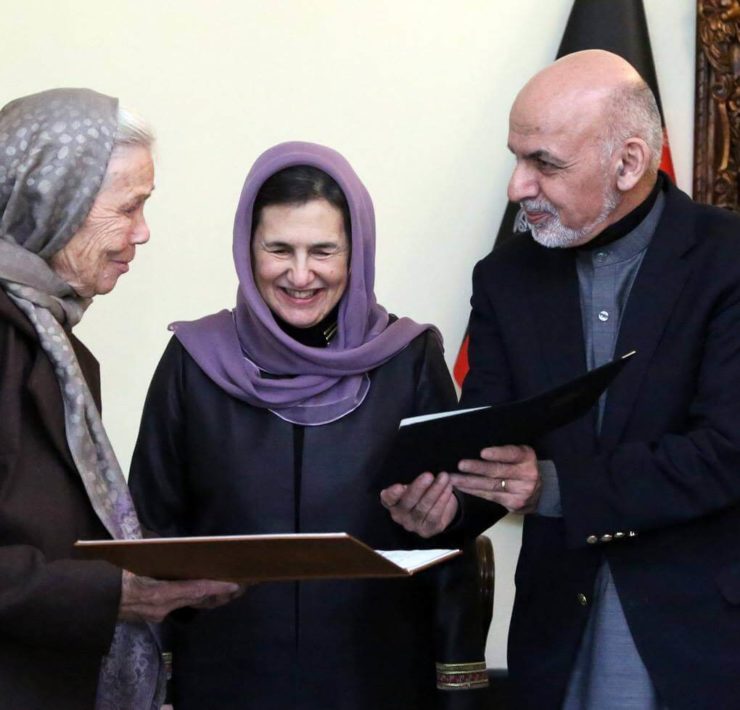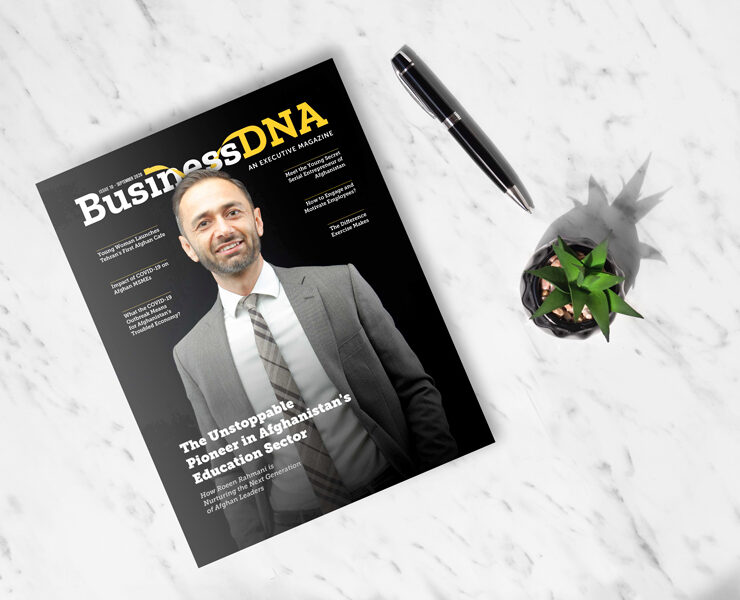An Interview By Jamshed Habibi

Through the Advancing Afghan Trade project, the European Union (EU) aims to keep Afghanistan’s economic momentum going. The AAT project (soon entering its second phase) is
funded by the EU and implemented by the International Trade Center (ITC) in Afghanistan. The first phase of the project launched at the end of January 2016 – after Afghanistan’s membership in the World Trade Organization – aiming to strengthen the country’s trade capacity while establishing a business-friendly environment. The project’s long-term vision is to transform Afghanistan and its regional partners into a vibrant regional economic hub. The three focus areas of prioritization include job creation, poverty reduction, and regional cooperation. The project allows Afghan enterprises to compete within regional and international markets and is aligned with the objectives of the Afghanistan National Peace and Development Framework (ANPDF).
The Ministry of Industry & Commerce is the main counterpart and beneficiary of AAT, while other organizations such as the Afghanistan Chamber of Commerce & Investment (ACCI), Afghanistan National Standards Authority (ANSA), and Afghanistan Customs Department (ACD) are subsidiary partners. In a recent statement, the EU Ambassador Pierre Mayaudon reaffirmed the European Union’s support to the second phase of the AAT project until 2024, building on the success of the first phase which will end in March 2020. In an interview with BusinessDNA, Ambassador Mayaudon provides an in-depth perspective into the project thus far, the objectives for its second phase, and what he believes is the key to continued Afghan economic prosperity.
Hello Mr. Ambassador. Thank you very much for speaking with BusinessDNA. Could you please tell us what the Advancing Afghan Trade project is about?
Ambassador Mayaudon: First, allow me to welcome you to the Delegation of the European Union in Afghanistan. This is my first interaction with BusinessDNA. I appreciate that there is at least one Afghan media platform that specializes in support of the country’s business sector development. The European Union in Afghanistan, despite all of the challenges and obstacles, is determined to support the Afghan private sector and the business community.
A few years ago, we launched phase one of the Advancing Afghan Trade Project (AAT), which is now in its final months. We will launch a second project shortly which can be considered as phase two of the previous project – but it has different objectives. For the EU, Afghanistan is the number one destination for providing development assistance worldwide. We have covered three sectors through the current seven-year development assistance plan. The first sector is sustainable growth and jobs creation, the second sector is service delivery and the third sector is promoting governance, human rights, and democracy
The AAT project falls under “sustainable growth and job creation.” Phase one was conducted with the International Trade Center (ITC) as our implementing partner. ITC, which is an organization affiliated with the World Trade Organization, will continue the objectives of AAT through phase two
Mr. Ambassador, what are the outcomes of the project in the last three years in relation to its initial objectives?
Ambassador Mayaudon: Several achievements can be highlighted under Phase 1 of the project. The first and most prominent achievement of the project is the assistance provided to the government of Afghanistan in shaping and endorsing the Afghan National Export Strategy (NES). NES and its associated action plans are developed in conjunction with the Afghan government and the private sector. This has been the most important segment of the project. The second achievement of the project was reached with support from ITC, where we conducted several training sessions for Afghan businesses in various locations. These training sessions were incredibly beneficial to Small & Medium Enterprises (SMEs), and the topics addressed during these training sessions were related to cross-border procedures and compliance with regional and global market requirements. The third achievement was the support provided to MoIC in addressing and conducting priority interventions that were identified with a certain sense of urgency under the NES.
In order to improve regional integration and international trade competitiveness for Afghan economic operators, it was imperative the ministry was facilitated in their processes. The fourth achievement of the project has been the encouragement of public-private dialogue inside and outside Afghanistan. The aim of these dialogues was to collectively figure out obstacles regarding domestic and regional trade and address them with maximum possible efficiency.
The project was initially planned for three years between 2017 and 2019. What are the reasons behind the EU’s decision to extend the project for another five years until 2024?
Ambassador Mayaudon: We have long-term objectives. When we started Phase 1, we were aware the project would certainly not answer all of the present concerns. The aim was to support the government in defining and implementing the necessary strategies to boost trade. After the successful implementation of Phase 1, we decided that Afghanistan could benefit from tailored support for specific sectors and target groups through the next project, AAT Phase 2. The integration of Least Developed Countries (LDCs) into the global trading system is of the highest priority for the EU – as a means for stimulating sustainable economic growth. We are encouraged by what has been achieved so far under Phase 1, and we also feel that we have a responsibility to do more for specific value chains. This is what we are going to do in Phase 2.
President Ghani has vowed to transform Afghanistan from an importing country to an export-led one. What priorities and strategies are outlined by the EU under the framework of the AAT project to support the Afghan government in achieving this goal?
Ambassador Mayaudon: I think the ambition flagged by President Ghani to transform Afghanistan into an export-oriented country is definitely a matter of priority and urgency – especially when you consider the ratio of imports and exports. Unfortunately, Afghanistan has one of the worst ratios worldwide. The AAT project directly supports President Ghani’s commitment to transition Afghanistan into an export-oriented country. First, the development of the NES is an important contribution to supporting this ambition. Phase 2 of the project will directly target Afghanistan’s trade balance in several ways. It will positively impact the competitiveness of Afghan products, and it improves connectivity with the region so that Afghan businesses have better access to markets in the region and beyond.
You mentioned Public-Private Dialogues. Are any platforms established yet?
Ambassador Mayaudon: An important step is to change mindsets within the government and the private sector. The EU is encouraging the administrations to have a more “business-friendly” attitude. This led us to establish the EU Business Council in Kabul two years ago. Members of this council include the Ambassadors of the EU Member States and a group of Afghan businesspeople. The main sectors of the Afghan economy such as agribusiness, extractives, IT, logistics, energy, recycling, etc. are represented in the council.

What specific support does the EU provide to businesses and government bodies who participate?
Ambassador Mayaudon: Every time we invite representatives of government institutions to the business council, we ask them to listen to the difficulties, challenges, and grievances of business owners – customs and taxes are the common issues. Our role is to establish these dialogues between the businesses and the government. We, the EU diplomats, act as catalysts promoting more transparency between both parties. It is not just for the government to better understand the entrepreneurs, but also for the entrepreneurs to better understand the decision-makers and policy-makers in the government.
When you sit with business leaders, what problems do they especially point out regarding doing business in Afghanistan?
Ambassador Mayaudon: Frankly speaking, when we discuss this topic with business leaders in the country, they don’t name physical insecurity and insurgency as their top concerns, but rather regularly refer to legal insecurity.
The legal framework is good, but the implementation is often not clear and straightforward. It is confusing for business actors. This is a significant source of difficulty if you are a businessperson in Afghanistan, as the sense of clarity regarding the implementation of legal frameworks is absent. The second challenge is the insufficiently-developed infrastructure – limited connectivity with the neighboring countries and beyond – also hinders the business. The third challenge is the supply of energy, which is neither sufficient nor consistent. If you are a businesswoman, be sure that the challenges will be multiplied even more so – i.e. the inability to obtain property titles and access as compared to men.
“For the EU, Afghanistan is the number one destination for providing development assistance worldwide.”
What privileges do the members of the European Union offer to Afghan exporters?
Ambassador Mayaudon: The EU offers Afghanistan, as one of the 49 LDCs, all the privileges granted under the Generalized System of Preferences (GSP) – EBA “Everything But Arms” initiative. This results in duty-free and quota-free access for all products – except arms and ammunition. This means that Afghanistan can export to the collective EU market of five hundred million consumers without being subjected to duties and quotas. Unfortunately, your businesses and companies do not take any significant advantage or benefit of this very unique and privileged market access regime.
“Afghanistan can export to the collective EU market of five hundred million consumers without being subjected to duties and quotas. Unfortunately, your businesses and companies do not take any significant advantage or benefit of this very unique and privileged market access regime.”
Why has the Afghan business not taken advantage of the provided privileges?
Ambassador Mayaudon: For multiple reasons. It is not because Afghanistan lacks potential. Potential is there, especially in the two sectors of agribusiness and extractives. But for both, primarily agribusinesses, a proper process of certification is missing. Agribusiness products require sanitary and phytosanitary standards to be met. In Afghanistan, there is no proper process of certification that would allow certification of Afghan agricultural products and thus their export to the EU market at a large scale.
If certification is one of the main obstacles, what particular recommendations and assistance can you provide to MoIC and specifically to the Afghanistan National Standards Authority (ANSA)?
Ambassador Mayaudon: First and foremost, EU-certified laboratories need to be established to confirm that agricultural products comply with EU sanitary and phytosanitary standards. Unless these laboratories are established, very small export volumes cannot tap into the potential of mass exports that could make a difference and address the priorities of advancing Afghanistan’s economy in becoming export-driven.
I attended the inauguration of the laboratories at ANSA, which were rehabilitated under Phase 1 of the project, and I realized more needs to be done, especially in agribusiness. The second problem I came across is that food products can be of high quality, but the volumes are not consistent. There is a lack of efficiency in agricultural product value chains. This is an impediment to the transition of Afghanistan into an export-driven economy. My recommendation is to focus on import substitution before considering exports in a big way. You could produce a number of products in Afghanistan that you import from other countries today. So, if you want to address the issues of trade deficit, I think you should start under your own roof by offering domestic products to Afghan citizens. That way, you will have built a strong basis for increasingly competitive products for export.
What hinders the growth of the extractive industries?
Ambassador Mayaudon: The first issue is a lack of large-scale investment. If you want to tap into the potential of Afghan mining and make it a game-changer, large-scale investment is imperative. The second issue is the lack of clarity regarding legal processes and regulations as highlighted by our members of the EU Business Council. During countless instances, mining contracts are being signed off but are not properly implemented. This results in discouragement of business people and their involvement in the sector. The third issue, albeit unsurprising, is corruption.
Afghanistan’s exports reached $1 billion in 2019 – an unprecedented figure in the country’s history. The increase was mostly fueled by the government’s subsidy to exporters. Do you think it’s sustainable in the long term?
Ambassador Mayaudon: The issue of sustainability is crucial. We hope the second phase of Advancing Afghan Trade will strengthen the sustainability of exports. But, at the moment, the business sector itself should be able to carry the associated costs. Today, the costs are shared with the government through subsidies. This is not sustainable. We have to be very sincere and realistic about this. One of the ambitions of Phase 2 is to address the issues related to connectivity and regional economic integration. The EU was born out of such economic integration. We know that South & Central Asia are among the least economically integrated regions in the world, but we also cannot minimize the necessity of finding solutions to the problem.

What are the main objectives of Phase 2 of Advancing Afghan Trade?
Ambassador Mayaudon: Phase 2 of the AAT project will have three main objectives. The first objective is to strengthen the business environment related to regional economic integration and connectivity. The second objective is to help the Afghan economy in improving its competitiveness and socio-economic and environmental responsibility for both agribusiness and manufacturing products, as identified in the National Export Strategy.
The priority sectors are:
- Saffron
- Fresh fruits and vegetables
- Dried fruits and nuts
- Carpets
- Marble and Granite
- Precious Stones and Jewelry
We will further capitalize on what has been done under Phase 1 and encourage the development of healthy competition within a selection of these priority sectors. And again, we encourage the development of a broader and stronger sense of responsibility among government and business actors. The third objective is to improve the potential of Afghan businesswomen within the regional and international trading sphere. Worldwide, you can find women’s economic empowerment at the very top of the EU global agenda. Supported by training on business skills, women can contribute to the expansion of the Afghan economy while simultaneously reaching the regional and international markets.
Besides reducing poverty and developing regional cooperation, the first phase of the AAT project aims to create jobs in Afghanistan. How many jobs has the project created so far, bearing in mind that 40% of the Afghan population still struggles with unemployment?
Ambassador Mayaudon: This is not the way that I would characterize the objectives of Phase 1. Our aim was to improve economic conditions. This will ultimately result in job creation at the end of the chain. When businesses are able to seize opportunities created by more robust and private-sector-oriented policies, we will witness job creation and poverty reduction.
What have been the direct and indirect contributions of the project in reducing poverty and food insecurity in Afghanistan? Based on recent studies, 55% of Afghans still live under the poverty line and 33% suffer from food insecurity.
Ambassador Mayaudon: The figures are all quite alarming. They underline the need to focus on economic growth. If the government provides the policy framework to match our projects supporting trade growth, and if businesses become more competitive and comply with international standards, then services will improve, jobs will be created, and poverty will be reduced.
Which countries can Afghanistan learn from in terms of advancement of trade and formulation of sound policies?
Ambassador Mayaudon: That is not an easy question to answer. Each country has so many characteristics of its own. Typically, the Afghanistan of 2020 is not the Afghanistan of ten or twenty years ago. Your country has become a member of the WTO. Your country has a broader vision of what an economy could be and should be. I would not take the risk of comparing Afghanistan with other countries. Trying to copy a model that has been successfully implemented in other countries, including in the region, may not be a good recommendation.
However, we have learned some lessons which can certainly be drawn from the experiences of other countries. These are universal solutions that need to be implemented, especially in combating corruption. Designing and implementing the best possible legal framework and administration in developing a “business-friendly” attitude toward the private sector are fundamental universal recommendations. But they are not enough. You have to clearly identify in the Afghan context why progress is unsatisfactory and what should be done.
Does the second phase of the project involve the development of a free trade zone with the EU?
Ambassador Mayaudon: You have duty-free and quota-free access to the European Union. Afghanistan should be in a place to take maximum advantage of this. Yet, this is not happening. EU and Afghanistan’s bilateral trade is estimated to be around 300 million euros of export and import, annually. This is not enough! The ambition of becoming export-oriented will only come true if Afghanistan establishes the proper measures needed to ensure certification of its export products. I do want to salute the initiative of the government in appointing trade attachés within several key Afghan diplomatic missions. Although more is needed, this is a very important step forward. Promoting Afghanistan and promoting Afghan products worldwide is imperative, and we are getting closer as time goes by.
MoIC aims to increase Afghanistan’s export volume beyond the current $1 billion by 2022. How will AAT assist MoIC in achieving this goal?
Ambassador Mayaudon: The objectives set by the government to move the country’s exports beyond the current one billion dollars are at the top of our agenda. The coherence between these different initiatives will bring efficiency in supporting the government and its capacity to strengthen the private sector. I would also say that encouraging and supporting the private sector to take advantage of opportunities in international markets is imperative. Here, we touch a little bit on the role of trade attachés. Their mission is to identify opportunities for the companies, bridging the gap between Afghan entrepreneurs and foreign markets. This is also a role that the EU can facilitate, especially through our business council. In this new phase, we are focusing on supporting and encouraging trade promotion and developing a proper economic network.
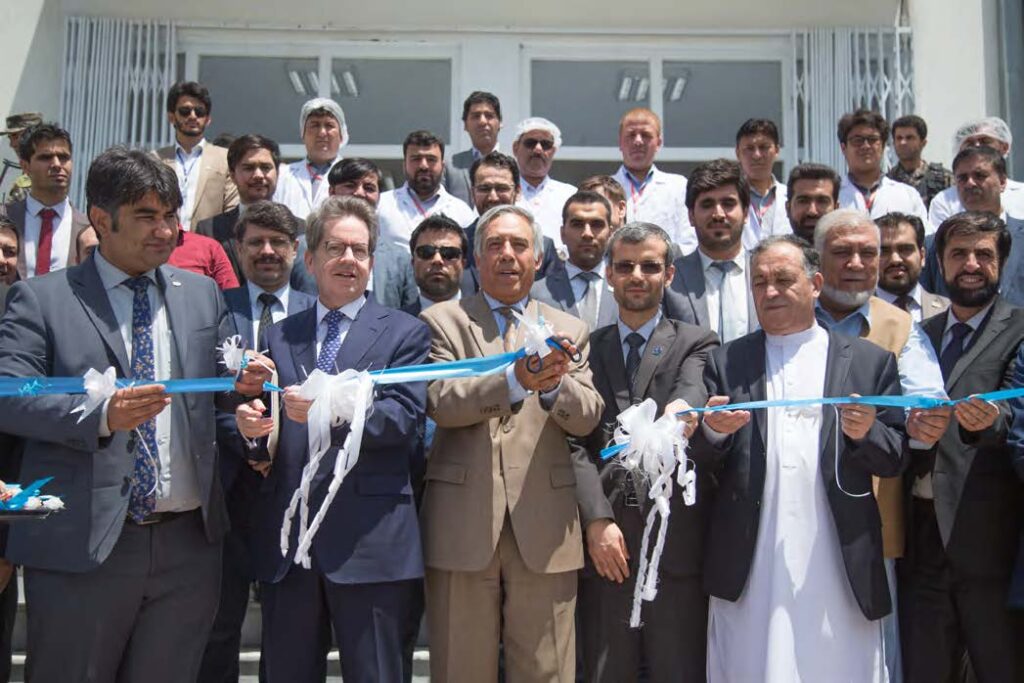
What expectations does the EU have from the Afghan government and the private sector in return for their support to boost Afghan trade?
Ambassador Mayaudon: Our aim is for the EU to continue to stand by the international partners of Afghanistan in pursuit of inducing progress that is sustainable and long-term for the country. These overarching ambitions are based on the goal of turning the Afghan economy from a war economy into a peace economy. This will not happen unless critical issues, such as illegal markets – trade of narcotics, illegal mining, and human trafficking- are directly dealt with and dismantled, allowing formalization of the Afghan economy. The other issue is that Afghanistan has a cash-based economy, which should be transformed so that it can properly be integrated into the international financial sphere. Last but not least, it is important to make sure that the Afghan economy, which today is still mostly a victim of its regional environment, becomes a beneficiary of this regional environment. The ambition should be to reach far and wide, and beyond Central & South Asia.
Thank you Mr. Ambassador. Would you like to share any closing comments with BusinessDNA’s readers?
Ambassador Mayaudon: I’d like to finish with a few words regarding “value addition”. You know, if you export apples, you are happy with the apple you have sold. However, you could also export apple juice, processed within Afghanistan. You export marble blocks, which are processed and subsequently exported by other countries under their own label, not marked as made in Afghanistan. These are all lost opportunities for Afghanistan to create more value and generate more income for the country. I know that President Ghani makes addressing the issues of the value chain a top priority. There is no shortcut to value chain development. If Afghanistan wants to raise its revenue from trade, it must be a collective initiative between the government and the private sector, supported by international partners. No doubt that the EU stands by your side.


